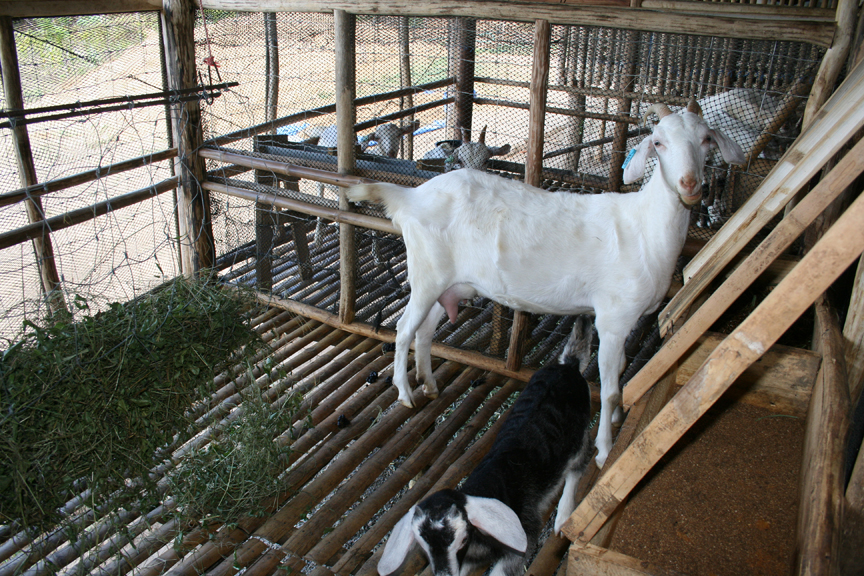Raising Goats a Guide to OFW's Part III
Mar 26, 2010 20:43:44 GMT -8
Farmer Nestor and reyel like this
Post by Farmer Nestor on Mar 26, 2010 20:43:44 GMT -8
It took us a year and half before we have a sustainable supply of forages in our farm, the next step we took was building our goat houses.
Housing
Unlike other livestock, goats prefer to stay on elevated places like benches, steps of houses, and piled lumber. Regardless of the types, goat houses must be well ventilated, well drained, and easy to clean. The materials to be used must be suitable to local conditions and depend upon the availability of the materials in the locality and the financial capability of the raiser. Nevertheless, it should be recognized that a good goat house must be able to serve the basic purpose for which it is built.
The primary function of a goat house is to provide protection for the animals against climatic elements such as rain, wind and temperature; and protection against theft, predators, infectious diseases, and traumatic injuries.
The goat house should be located in an area in the farm where it would be accessible, protected by natural windbreaks, and easily supplied with potable water.
Flooring
The floor can be constructed with bamboo or wooden slats, evenly spaced to allow manure to pass down. Floors should be at least 1 to 1.5 meters in height for ease of cleaning. Plastic flooring are also available in the market.
The Recommended floor space area for goats at different ages
1. Breeding female 1.5m2
2. Breeding buck 2.0m2
3. Young stock (up to one year old) 1.0m2
Pens and Partitions
Goats of different physiological stages should be separated. This can be achieved by strategic construction of partitions or walls to make pens.
1. Kidding and rearing pen
2. Buck pen
3. Dry does and and doeling pen
4. Grower pen
The pen allocated for does that are ready to give birth should be located at the farther end of the barn to give the does a quiet environment during kidding and subsequent rearing of the newly born kid(s). Locate also the pen designated for the buck besides the pen of the dry does and doelings. The presence of the buck has a positive effect on the occurrence of estrus in goats.
Roofs and its Design
The design of the roof should be considered to ensure adequate ventilation.
Under Philippine conditions the open roof type is recommended. This type allows warm air inside to flow out of the building. The improve circulation of air inside the building provides fresh air to the goats and prevents buildup of odor and gases given off by goats breath and their waste.
Other Facilities inside the Goat House
1. Feeding through
2. Isolation/Quarantine area
3. Loafing area
This is our goathouse using indigenous materials.

Inside the goathouse

The growing pen

Next buying your stock and goat nutrition...
Housing
Unlike other livestock, goats prefer to stay on elevated places like benches, steps of houses, and piled lumber. Regardless of the types, goat houses must be well ventilated, well drained, and easy to clean. The materials to be used must be suitable to local conditions and depend upon the availability of the materials in the locality and the financial capability of the raiser. Nevertheless, it should be recognized that a good goat house must be able to serve the basic purpose for which it is built.
The primary function of a goat house is to provide protection for the animals against climatic elements such as rain, wind and temperature; and protection against theft, predators, infectious diseases, and traumatic injuries.
The goat house should be located in an area in the farm where it would be accessible, protected by natural windbreaks, and easily supplied with potable water.
Flooring
The floor can be constructed with bamboo or wooden slats, evenly spaced to allow manure to pass down. Floors should be at least 1 to 1.5 meters in height for ease of cleaning. Plastic flooring are also available in the market.
The Recommended floor space area for goats at different ages
1. Breeding female 1.5m2
2. Breeding buck 2.0m2
3. Young stock (up to one year old) 1.0m2
Pens and Partitions
Goats of different physiological stages should be separated. This can be achieved by strategic construction of partitions or walls to make pens.
1. Kidding and rearing pen
2. Buck pen
3. Dry does and and doeling pen
4. Grower pen
The pen allocated for does that are ready to give birth should be located at the farther end of the barn to give the does a quiet environment during kidding and subsequent rearing of the newly born kid(s). Locate also the pen designated for the buck besides the pen of the dry does and doelings. The presence of the buck has a positive effect on the occurrence of estrus in goats.
Roofs and its Design
The design of the roof should be considered to ensure adequate ventilation.
Under Philippine conditions the open roof type is recommended. This type allows warm air inside to flow out of the building. The improve circulation of air inside the building provides fresh air to the goats and prevents buildup of odor and gases given off by goats breath and their waste.
Other Facilities inside the Goat House
1. Feeding through
2. Isolation/Quarantine area
3. Loafing area
This is our goathouse using indigenous materials.

Inside the goathouse

The growing pen

Next buying your stock and goat nutrition...




